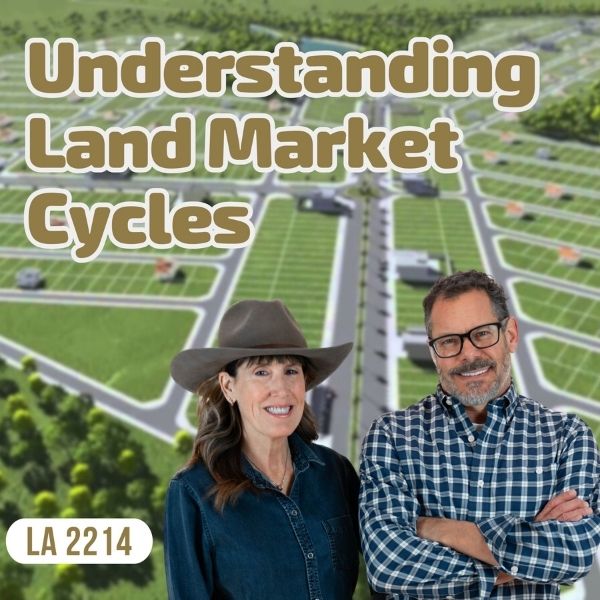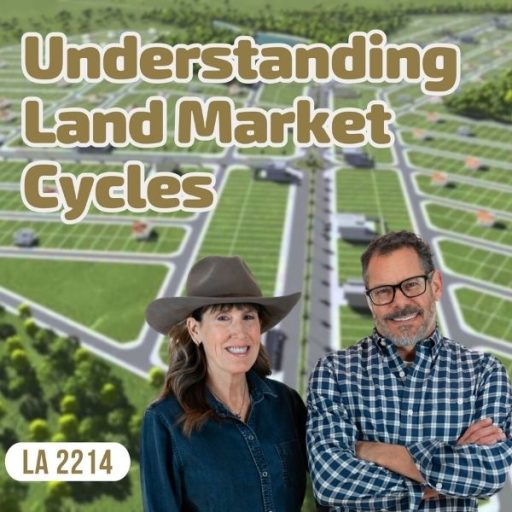This is episode 2214. Jill and I are talking about understanding the four land market cycles and acting accordingly.
Here’s my contribution. I’m going to try to make this fun and interesting because this title already puts me to sleep. I have to be honest, and I’m sure I’m not alone. Please leave a note in the comments if you agree with me, like, “I can’t believe I’m listening to this.”
What would you like to talk about? I can do this topic in 4 or 5 minutes.
We can talk about this, but it sounds boring.
As much experience as I have in real estate, I did not know about this until around 2023.
Do you know what would be a better title? It’s like, “How To Not Crash and Burn Like I Did In 2008.” Now, I want to listen.
Let’s talk about that.
It relates to the cycles. This is my point. A different title would have been better.
We’ll do the question like we always do. We’ll talk about it. When we get to the actual meat of the show, I’ll talk for thirteen seconds about the four cycles of real estate because, especially if you’re new, everybody needs to know what they are. We’ll apply it to 2008.
Part of it is that you think you will crash and burn. If you don’t plan for these cycles and act accordingly, then you will. Otherwise, if you plan for these, you won’t crash and burn.
It’s not that boring.
Yes, because I saved it.
Jill, you’re amazing. Each day on the show, we answer a question from our Land Academy member Discord forum. We take a deep dive into land-related topics by popular request.
I’m going to rewrite this question for everyone.
This is Nerd Day, and Jill doesn’t know what to do. This is nerdy technical stuff that Jill wants to blast.
It’s just that Neil is writing a question at the advanced or doctoral level. I want to make sure everybody understands what this means. Neil is clearly in Zillow, Realtor, or something like that. He’s comparing the active properties listed for sale versus the sold comps. He’s saying, “When the number for sale is less than the number sold, meaning the properties are in high demand because there are fewer active than there are sold, then why would sellers be motivated to sell them at 25% of the market price?”
Identifying Motivated Sellers Through Life Events
This is an incredibly good question. Here’s the fun answer for Jill. People sell real estate under its current published internet value, not their brother-in-law value, because they have had or are experiencing a life event. They need the money and/or they need to move. That’s the reason. If you’re new in this business, you have to undo this natural thought that people know what their house or their piece of land is worth, which they don’t, most of the time, and disconnect the correlation between price and saleability.
What you’re truly fishing for when you’re out there is a life event. That’s why we encourage you to send a ton of mail out, because let’s say I haven’t had a life event yet this week. I could have tomorrow or Saturday. I have a life event on Tuesday, and I will get your letter on Wednesday. I’m going to respond to it. I’m not going to respond this week, though, because everything is good.
I have a job. Everybody is healthy. Nothing is going on, and then my plant closes, we’re laid off, they’re downsizing, or who knows what it is. You’re like, “What are we going to do?” You’re looking around the house, going, “What can I sell? Do I sell a car?” The letter arrives. You’re like, “I forgot we even had this land, and someone even wants it. They’re going to give me $23,000 in two weeks. They can close that fast. I’m calling them. I need that. I don’t have time to wait for anything else. I’m certainly not going to list it, get pictures, wait six months, and fingers crossed. I want the $23,000 right now.”
If Jill and I went down the list of deals that we’ve done so far, she could tell you in great detail what is happening in that seller’s life and why.
That’s why I changed my whole script. I’ve talked about this, which is before I even talk money with the people, I want to know what is going on. I want to identify that they are having a life event. This is the right timing moment for them, because then I’m going to solve this problem with them and for them that much faster.
I have to add this before we move on to the actual topic. There’s always somebody in a group when Jill and I do this live or when we explain it, like we are right now, who says, “You’re taking advantage of somebody.” Here’s the deal. If the seller had a life event on Tuesday, and I’m a real estate agent who says, “Do you want to sell your house?” on Wednesday, their response is going to be yes. It’s about three weeks to a month before it ever even gets listed because it’s got to be cleaned up, and all kinds of things have to happen. There’s so much paperwork involved.
They have to confirm that they own it. There’s a lender. There are a lot of things that are very complicated that stand in the way of even the best real estate agents getting stuff listed and then getting it sold. Listing it is a 30-day event. Having it active is at least a 30-day event. If the buyer has a mortgage, it’s maybe a 30 to 60-day event. That’s just how it is.
People are going to disagree with my numbers, but here’s my point. It’s complicated to sell a piece of property through a real estate agent. You can sign our letter, talk to Jill, or write your letter, in Neil’s case, and sell the property within days. We are ungoverned as non-licensed real estate agents, and so are you, if you’re not licensed to buy and sell property. It takes us 3 or 4 days to buy and to get a property into our name in these circumstances in the Southwest. Every state is different. Every circumstance is different, but it’s very quick. It’s convenient.
We can go on and on about that, but we won’t.
Our topic is understanding land market cycles and acting accordingly. Even though Jill thinks this is boring, I think it’s fascinating.
It’s just the title. That’s what was snoozing me.
The Four Land Market Cycles Explained
There are four components to every real estate cycle. The one that we’re in right now is hypersupply, and we’re headed very quickly into a recession. We had a terrible real estate depression last time that I think ended around 2011. We’ve been in this cycle ever since that in real estate. In 2011, we were in recovery. Recovery means there’s a declining vacancy and no real new construction. That’s phase one. Phase two is declining vacancy. It’s called expansion. There is no construction because the demand isn’t there. Phase three is hypersupply. It’s been overbuilt. We make money between all these stages. That’s the whole key takeaway here.
Phase three, hypersupply. There is an increasing vacancy and new construction. You don’t go from phase two to phase three overnight. It takes years in most cases. We’re at the end of a cycle. We’re about to go into a real estate recession. This whole cycle started in 2008. That’s quite some time ago. Finally, phase four is recession, which is increasing vacancy and more construction completions. It’s very easy in all these markets to buy real estate because we’re not as subject to the economic things that surround these phases. What we’re looking for is what we explained, which is why I associated the question with this actual topic. We’re looking for a personal circumstance.
It’s almost fifteen years ago. That’s how long it has taken us to get to this cycle.
This is the longest cycle I remember.
What’s great about that is we can go back. It’s fun to go back when you and I do our Thursday number calls. You look at the data of the swings, interest rates, and stuff like that. They go back years or decades, so you can tie these cycles to a lot of the data that we can get our hands on for free.
Strategic Buying In Recessionary Periods
A substantial percentage of the land out there is “unwanted.” In a recessionary period where you’re having other things go on in your life, that percentage theoretically goes up a little. It’s easier to buy property super cheap, but not as easy to sell it in these recessionary times. To combat that, we heavily encourage you to buy properties that are 15% to 20% of the posted retail value. It’s predictable. In the first few cycles that I went through back in the 1990s, and then the 2000s, when it was in a recessionary scenario, like many people, in the back of my head, I said, “That’s it.” I’m watching our children, especially number three, who was in his early twenties. He thinks it’s over.
“We bought it all. We can never buy a house. We wrecked it. Your interest rates screwed us.” What else did we do wrong? This is good. Let’s see here. “The way that speeding tickets are delivered, you ruined that for me.” Let’s see what else.
It’s a cycle. I remember being that age and thinking, “My parents and grandparents wrecked it. We’ll never be able to buy houses this cheap again.” Here we are. There’s a saying that I’ll never get used to, but in Southern California, I’ve heard many people say it in the real estate industry. “The house doubles every ten years.” I sit for a while. I fought that. I went and looked back, and it’s true. It does every ten years, regardless of the cycle. Does that happen in Ohio? Not at all.
All I’m saying is be aware of these cycles and use them to your advantage. Apply common sense. Do a bunch of research on it. You can buy and sell real estate during every cycle very successfully. Join us in the next episode, where Jill and I discuss why community is the secret ingredient to longevity in the land business. You are not alone in your real estate ambition. We’re Jack and Jill, information and inspiration to buy undervalued property.















